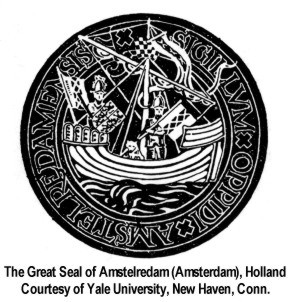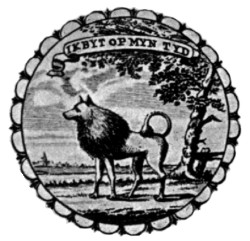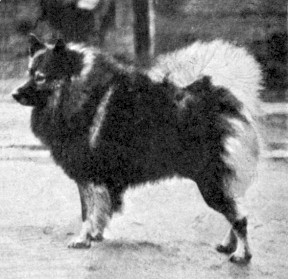The Canal Dog
Author unknown
Although they still make good boat dogs, Keeshonden are
much more popular now as shore-bound guardians and companions.
 There is a legend dating back to 800 AD in which two men and
a dog, at sea in a fishing boat, are caught in a violent storm
in the black of night. Driven off course into unfamiliar waters,
the men are certain they will perish, until, unexpectedly, they
reach shore. The men survive the ordeal, and thereafter look
upon the dog, who also escapes without harm, as the talisman
for their good fortune. From that day forth, it was considered
lucky to have a dog aboard a ship. The great Seal of Amsterdam,
the city where the troubled fishing boat is believed to have come
ashore, displays a ship bearing two men and a dog.
There is a legend dating back to 800 AD in which two men and
a dog, at sea in a fishing boat, are caught in a violent storm
in the black of night. Driven off course into unfamiliar waters,
the men are certain they will perish, until, unexpectedly, they
reach shore. The men survive the ordeal, and thereafter look
upon the dog, who also escapes without harm, as the talisman
for their good fortune. From that day forth, it was considered
lucky to have a dog aboard a ship. The great Seal of Amsterdam,
the city where the troubled fishing boat is believed to have come
ashore, displays a ship bearing two men and a dog.
So it was that many of the cargo vessels that traversed the misty
canals of Holland before the 18th century were tended by a beautiful
and popular dog, little known to the rest of the world until political
events in the Netherlands brought the breed to international
prominence. The Keeshond (pronounced "caze-hawnd") was not only
valuable as a watchdog and companion to the bargemen, but
to farmers, as well.
 In 1781, the Conservative Dutch political party known as the Orangists
(supporters of the Prince of Orange) was opposed by the Patriots
(the rebellious "People's Party"). Cornelius "Kees" de Gyselaar,
the rebel leader, had as his constant companion a beloved pet dog
who eventually became the symbol of his political party. "Kees' hond"
appeared in many political cartoons of the day. The appellation stuck,
but when the party was defeated and the Orangists led the country,
many Keeshond owners did away with their dogs, afraid of being
identified with the now unpopular Patriots. (Shown to the left is
a Dutch political lampoon of the 18th century, depicting the Keeshond
in the popular trim of the time - "lion clip".)
In 1781, the Conservative Dutch political party known as the Orangists
(supporters of the Prince of Orange) was opposed by the Patriots
(the rebellious "People's Party"). Cornelius "Kees" de Gyselaar,
the rebel leader, had as his constant companion a beloved pet dog
who eventually became the symbol of his political party. "Kees' hond"
appeared in many political cartoons of the day. The appellation stuck,
but when the party was defeated and the Orangists led the country,
many Keeshond owners did away with their dogs, afraid of being
identified with the now unpopular Patriots. (Shown to the left is
a Dutch political lampoon of the 18th century, depicting the Keeshond
in the popular trim of the time - "lion clip".)
 At the same time, the Keeshond was also losing his popularity as a
barge dog. As they became roomier, vessels were able to
accommodate the larger breeds of guard dogs. Aside from a few
bargemen and farmers, who remained loyal to the breed, Keeshonden
virtually vanished in Holland until the 1920s. Then, through the
efforts of the Baroness van Hardenbroek, interest in the breed was
revived and enthusiasm soon spread throughout Europe. Her own dog,
Champion Bart (pictured to the right), is recorded in many
modern pedigrees.
At the same time, the Keeshond was also losing his popularity as a
barge dog. As they became roomier, vessels were able to
accommodate the larger breeds of guard dogs. Aside from a few
bargemen and farmers, who remained loyal to the breed, Keeshonden
virtually vanished in Holland until the 1920s. Then, through the
efforts of the Baroness van Hardenbroek, interest in the breed was
revived and enthusiasm soon spread throughout Europe. Her own dog,
Champion Bart (pictured to the right), is recorded in many
modern pedigrees.
The first Keeshonden were brought to the United States in 1926 by
Mr. Carl Hinderer, a German immigrant who lived in Baltimore. After
many trips to New York to show his dog, Wachter Schwartz, to the
officials of the AKC, the breed was finally recognized in 1930 as
one of the non-sporting group. (Click here to read the
American Kennel Club's Standard for the Keeshond)
(The Keeshond was first registered in Canada in the years 1928 - 1929.
Click here to read the Canadian Kennel Club's Standard
for the Keeshond)
It seems odd that a dog know fondly as "the laughing Dutchman"
and "the gentleman from Holland' could have had such a tumultuous
history. The modern Keeshond is one of the gentlest of dogs. Never
bred as a hunter and never used for any other specialized work,
these dogs are companions extraordinaire and great home lovers. Mr.
Bob Priest, president of the Keeshond Club of America, believes it
is this friendly, gently devotion that makes the Keeshond unique.
Indeed, anyone who had owned a Keeshond would agree with his statement
that this is a dog that wants to please; an affectionate dog with a
wonderful disposition.
Let it not be said, however, that the Keeshond is not a good watchdog.
His intelligence and devotion to his home makes him very protective and
keenly alert to any stranger who may approach, as a pamphlet put out by
the Keeshond Club of America states. But, it goes on to say, "Keeshonden
are not attackers or yappers, and quickly offer their friendship to those
who are welcomed by their owners." Typically, they are not afraid of
anything or anyone.
Keeshonden also excel in all phases of obedience. The first obedience
team formed in the U.S. consisted of four Keeshonden. It was headed by
Mr. Milo Pearsall, a devoted Keeshond Fancier and author of the now-classic
book, Dog Obedience Training.
The Keeshond is a medium-sized dog whose distinctive appearance attracts
much attention. The coat is silver-grey to black with a pale gray or cream
undercoat. The muzzle should be dark and there should be the characteristic
black "spectacles" around the eyes. Ears are held upright. The neck sports
a lion-like mane, and the tail is plumed and carried over the back. The hind
legs, dense with fur, form the well-known "trousers."
Prices for the Keeshond pups vary widely. Show quality pups may sell for
anywhere from $150 to $500, depending on lineage and area of the country,
but the national average is about $300. The typical litter may include up
to eight puppies. (Note: These prices are no longer accurate.)
As with all dogs, it is wisest to obtain a Keeshond puppy from a reputable
breeder. Most professional breeders, besides having given their pups proper
care from the very start, are genuinely concerned about the welfare of their
pups and want to see them go to good homes. In addition, a good breeder can
advise you on selecting the puppy that is best for you, as well as offer you
the benefit of his expertise in all matter of care and training.
All rights reserved. ©
1998 - 2010 Klompen Keeshonden.
This and subsequent pages may be reproduced, but only with permission
from Kathy Stewart.
 There is a legend dating back to 800 AD in which two men and
a dog, at sea in a fishing boat, are caught in a violent storm
in the black of night. Driven off course into unfamiliar waters,
the men are certain they will perish, until, unexpectedly, they
reach shore. The men survive the ordeal, and thereafter look
upon the dog, who also escapes without harm, as the talisman
for their good fortune. From that day forth, it was considered
lucky to have a dog aboard a ship. The great Seal of Amsterdam,
the city where the troubled fishing boat is believed to have come
ashore, displays a ship bearing two men and a dog.
There is a legend dating back to 800 AD in which two men and
a dog, at sea in a fishing boat, are caught in a violent storm
in the black of night. Driven off course into unfamiliar waters,
the men are certain they will perish, until, unexpectedly, they
reach shore. The men survive the ordeal, and thereafter look
upon the dog, who also escapes without harm, as the talisman
for their good fortune. From that day forth, it was considered
lucky to have a dog aboard a ship. The great Seal of Amsterdam,
the city where the troubled fishing boat is believed to have come
ashore, displays a ship bearing two men and a dog. In 1781, the Conservative Dutch political party known as the Orangists
(supporters of the Prince of Orange) was opposed by the Patriots
(the rebellious "People's Party"). Cornelius "Kees" de Gyselaar,
the rebel leader, had as his constant companion a beloved pet dog
who eventually became the symbol of his political party. "Kees' hond"
appeared in many political cartoons of the day. The appellation stuck,
but when the party was defeated and the Orangists led the country,
many Keeshond owners did away with their dogs, afraid of being
identified with the now unpopular Patriots. (Shown to the left is
a Dutch political lampoon of the 18th century, depicting the Keeshond
in the popular trim of the time - "lion clip".)
In 1781, the Conservative Dutch political party known as the Orangists
(supporters of the Prince of Orange) was opposed by the Patriots
(the rebellious "People's Party"). Cornelius "Kees" de Gyselaar,
the rebel leader, had as his constant companion a beloved pet dog
who eventually became the symbol of his political party. "Kees' hond"
appeared in many political cartoons of the day. The appellation stuck,
but when the party was defeated and the Orangists led the country,
many Keeshond owners did away with their dogs, afraid of being
identified with the now unpopular Patriots. (Shown to the left is
a Dutch political lampoon of the 18th century, depicting the Keeshond
in the popular trim of the time - "lion clip".) At the same time, the Keeshond was also losing his popularity as a
barge dog. As they became roomier, vessels were able to
accommodate the larger breeds of guard dogs. Aside from a few
bargemen and farmers, who remained loyal to the breed, Keeshonden
virtually vanished in Holland until the 1920s. Then, through the
efforts of the Baroness van Hardenbroek, interest in the breed was
revived and enthusiasm soon spread throughout Europe. Her own dog,
Champion Bart (pictured to the right), is recorded in many
modern pedigrees.
At the same time, the Keeshond was also losing his popularity as a
barge dog. As they became roomier, vessels were able to
accommodate the larger breeds of guard dogs. Aside from a few
bargemen and farmers, who remained loyal to the breed, Keeshonden
virtually vanished in Holland until the 1920s. Then, through the
efforts of the Baroness van Hardenbroek, interest in the breed was
revived and enthusiasm soon spread throughout Europe. Her own dog,
Champion Bart (pictured to the right), is recorded in many
modern pedigrees.